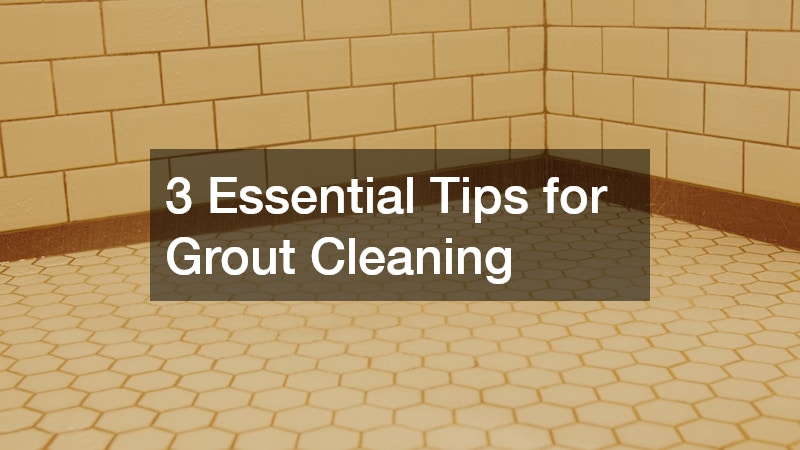
Grout cleaning plays a vital role in keeping your tiled surfaces both functional and visually appealing. However, over time, grout can accumulate dirt, mould and bacteria that not only dulls your space but can also lead to long-term hygiene issues. Whether you’re maintaining a newly renovated bathroom or refreshing kitchen floors, proper grout maintenance ensures lasting durability and cleanliness. Here are three essential tips to help you maintain spotless grout and extend the life of your tiled surfaces.
1. Use the Right Cleaning Products
Choosing the correct cleaning solution is the foundation of effective grout care. Many homeowners unknowingly damage their grout by using harsh chemical cleaners that degrade its integrity. Acid-based products may seem like a quick fix for stains, but they can erode grout lines over time, especially on older or unsealed surfaces.
Instead, opt for pH-neutral cleaners specifically formulated for tiles and grout. These products gently lift dirt and grime without causing structural harm. If you’re leaning toward a DIY approach, a simple mix of baking soda and water works as a mild abrasive that’s safe for most tiled areas. Apply it with a soft-bristled brush, scrub gently and rinse thoroughly with warm water. For stubborn spots or areas prone to mould, a solution of vinegar and water may be effective, but only use it sparingly and never on natural stone tiles, as vinegar can cause etching.
When shopping for commercial cleaners, look for eco-friendly options that are biodegradable and free of harsh fumes. These choices not only protect your surfaces but also keep your home safer for children and pets. Always test any product in a hidden spot before full application to avoid unexpected discolouration or surface damage.
2. Adopt a Consistent Cleaning Routine
Grout cleaning shouldn’t be an occasional chore reserved for spring cleaning. Regular upkeep prevents dirt, soap scum and mildew from taking hold. A weekly wipe-down of tiled areas using a damp cloth or mop can make a significant difference in maintaining your grout’s appearance and longevity.
Pay special attention to high-traffic zones such as bathroom floors, kitchen splashbacks and entryways. These areas accumulate the most moisture and debris, creating the perfect breeding ground for mould. After each shower or mop, try to dry the surface with a towel or squeegee to limit moisture exposure. The less standing water left behind, the less chance there is for bacteria and mildew to settle in.
For deeper grout cleaning, set a monthly schedule to scrub the grout lines using your chosen gentle cleaner. This routine helps remove embedded particles that daily cleaning might miss. For households with pets or young children, more frequent maintenance may be necessary to prevent the fast build-up of grime and allergens.
Vacuuming before mopping is another overlooked but critical step. It removes dry debris that could otherwise turn into muddy residue during wet cleaning. Preventing soil from entering your grout lines in the first place is just as important as cleaning it out.
3. Seal Your Grout for Long-Term Protection
One of the most effective yet underutilised strategies for maintaining grout is sealing it properly. Grout is naturally porous, which means it absorbs moisture, oils and dirt easily. Without a protective sealant, all your cleaning efforts may eventually go to waste as grime seeps deeper into the material.
Sealing forms a protective barrier that repels contaminants and makes future cleaning far more effective. There are various types of grout sealers, including penetrating sealers and membrane-forming sealers. Penetrating sealers soak into the grout and protect without altering the surface’s look, making them ideal for most residential applications. Membrane-forming sealers create a visible layer on top of the grout and are often used in areas prone to heavy water exposure.
It’s best to seal grout about 72 hours after installation or deep cleaning to ensure the surface is completely dry. Reapplication is typically needed every 6 to 12 months, depending on usage and the type of sealer used. Check manufacturer guidelines or consult a professional if unsure about timing or product choice.
If you’re planning a home improvement project, consider using pre-sealed grout or epoxy grout, which is inherently water-resistant and doesn’t require additional sealing. This option provides a more maintenance-free alternative for areas like showers and kitchen backsplashes.
Grout cleaning doesn’t have to be overwhelming. By using suitable cleaning products, sticking to a consistent routine and sealing your grout, you can significantly reduce grime build-up and preserve the appearance of your tiled surfaces. These three simple yet effective steps not only enhance the look of your home but also contribute to a cleaner, healthier living environment.
.




